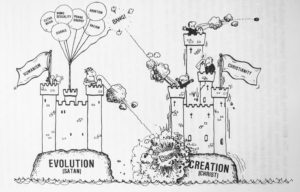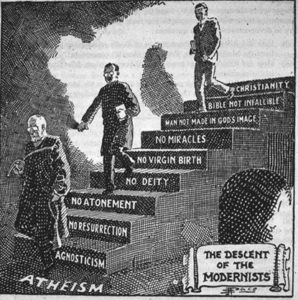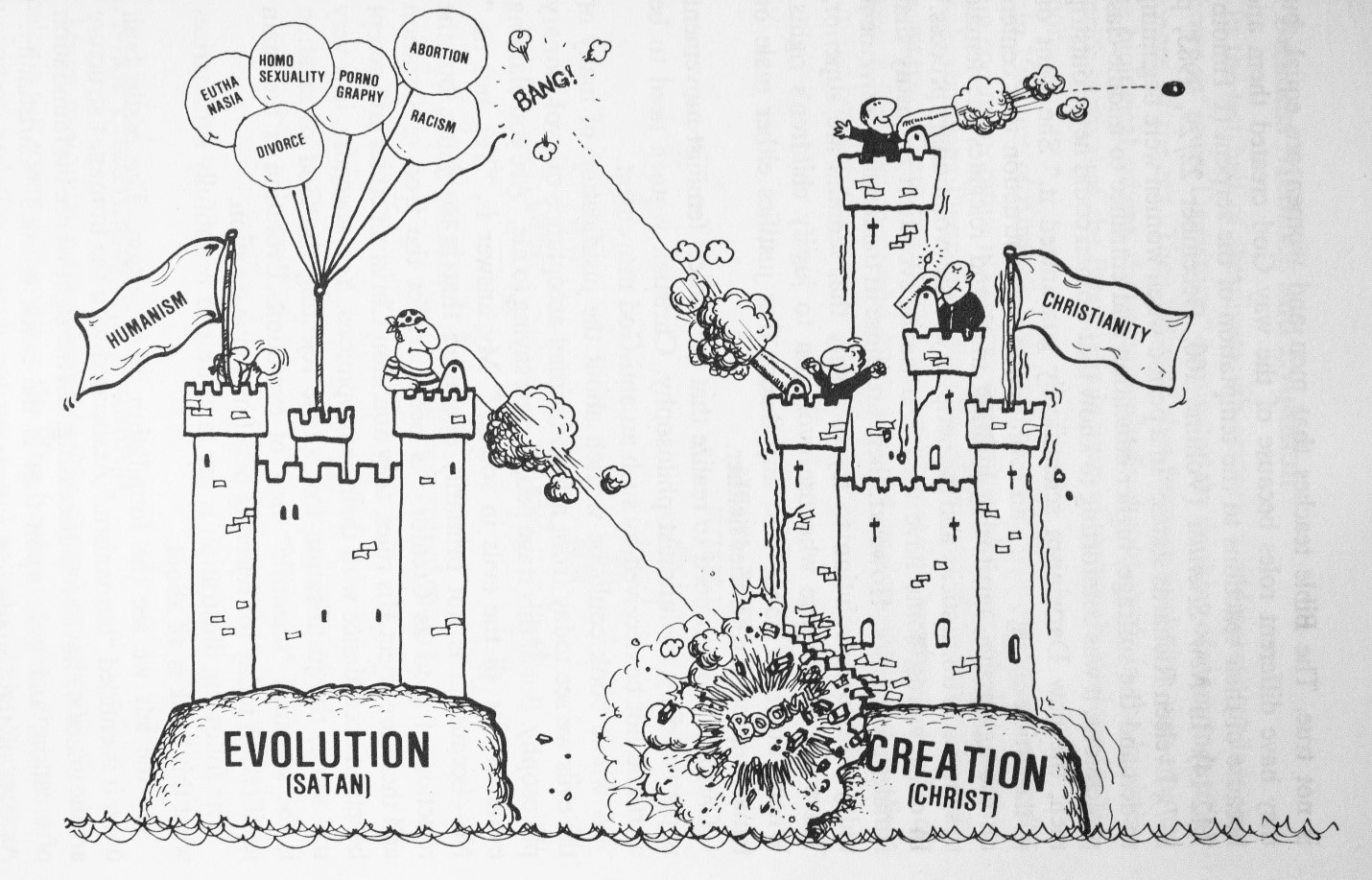
The cartoon image here portrays a war between Humanism and Christianity, where Humanism is founded on evolution and Satan, while Christianity is founded on creation and Christ. The castle of Christianity is starting to collapse as the castle of Humanism systematically attacks the rock of its foundation in the cartoon, creation. The Christian guns are ineffectively aimed either nowhere or at the balloons (issues) of humanism instead of it evolutionary foundation. The message it sends is clear: Christianity is in danger of losing the cultural war with Humanism because it isn’t attacking the Satanic foundation it’s based on, evolution.
The cartoon originally appeared in a 1987 book by Ken Ham titled: The Lie: Evolution. In “Creation, Culture Wars, and the Search for Certainty,” Ted Davis said it has been the “signature icon” for Answers in Genesis (AiG), an organization founded by Ken Ham. Over time the image has been modified, as it reflected the ‘evolution’ of Ham’s and AiG’s thought. “Over time, I began to emphasize that believing in the creation account in Genesis means accepting God’s Word as the ultimate authority, and believing in the secular idea of evolution is to accept man’s word as the ultimate authority.”
In a 2002 version of the cartoon, the castle of Christianity was represented as being founded on six literal creation days equaling God’s authority, versus the millions of years equally man’s authority for the foundation of the humanism castle. In 2010, the foundations were “no longer creation vs. evolution or six days vs. millions of years, but ‘autonomous human reasoning”’ vs. ‘revelation/God’s word.’” See “Creation and Culture Wars” for the images.
Although Ham’s signature icon is still very much alive, it has evolved into a more sophisticated new species that is better adapted to twenty-first century culture wars, in which biblical faith is increasingly seen as contrary to science and reason. Ironically, Ham’s ministry itself is a primary cause of that perception.
Ted Davis noted how Ken Ham echoes the belief of William Jennings Bryan in the early twentieth century, that evolution inevitably undermines Christian faith. Like Ham, Bryan represented his thought in a cartoon. He saw evolution as causing modernism and leading to “the progressive elimination of the vital truths of the bible.” Bryan’s cartoon has three modernists, a student, a minister and a scientist descending a staircase that represents a slippery slope stemming from “the progressive elimination of the vital truths of the bible.” The descent starts with evolution and ends with the scientist stepping from Agnosticism to Atheism.

The “Descent of the Modernists” cartoon appeared originally in Bryan’s 1924 book, Seven Questions in Dispute, published the year before his death, which took place days after his participation in the infamous Scope Trial. See “’Conflict Between Science and Religion’” and “No Contest; No Victory” for more on Bryan.
Despite the parallels in their thinking about creationism and the culture, Davis noted that Henry Morris, not Bryan, had the greater influence on Ham’s thought. AiG refers to the late Henry Morris as ‘the father’ of the modern creationist movement. His book, The Genesis Flood (1961), was the beginning of the revival of creationist thought that faded from the church with the passing of Bryan and the retreat of fundamentalism from cultural engagement after the Scopes Trial. Davis noted that in another book by Morris, The Troubled Waters of Evolution (1974), he argued evolutionary thought could be traced back beyond the “evolutionary pantheists” of the ancient Greco-Roman world. True as far as that statement goes, Davis noted where “Darwin’s theory was immensely more sophisticated and far more plausible than any ancient theory—but Morris goes much further.”
Morris traced the origins of evolutionary thought back through all the religions of the world other than Christianity, Judaism and Islam. These are excluded because they are based on Genesis. All other religions are “evolutionary” religions, including: Buddhism, Hinduism, Taoism, Confucianism, Atheism and ‘liberal Christianity.’ He said that evolution itself is a religion. He does not mean Darwinian evolution, but belief in the idea that all things have arisen by innate processes in the universe: the belief that the universe had no beginning; that it is eternal. You can watch a YouTube video series of a talk Morris gave titled “The Troubled Waters of Evolution.” It is in five parts. If you watch Part 1, notice the parallels between the metaphor Morris uses of the “fruit tree” of evolution producing harmful philosophies and evil practices the humanistic “balloons” in Ken Ham’s cartoon.
But Morris goes back even further in his book, The Troubled Waters of Evolution, according to Davis. He attributes the origins of evolution with Nimrod and the Tower of Babel in Genesis 10:8-10. According to Morris, it was part of the pantheistic polytheism of Babel Connected with astrology, idolatry, and the worship of fallen angels. “It is therefore a reasonable deduction, even though hardly capable of proof, that the entire monstrous complex [of evolution] was revealed to Nimrod at Babel by demonic influences, perhaps by Satan himself.” Therefore, evolution is “the world-view with which the whole world has been deceived.”
That’s why the foundation of Ham’s humanism castle connects evolution with Satan—and why evolution gets blamed for social ills that plagued us long before Darwin was born and would still be prevalent today even if Darwin had never existed. Evolution becomes the scapegoat for many sinful behaviors, to such an extent that it is virtually equated with sin itself, or even seen as inherently Satanic. This is a profoundly unhelpful way of approaching historical and cultural aspects of evolution, and it fails entirely to explain why many people who utterly reject evolution commit the very sins that Ham connects with belief in evolution.
Despite the revisions over time to the AiG “signature icon,” its foundations have actually changed very little. For AiG, Christianity sits on the foundation of “Creation;” which means “6 (24 hour) Days” for creation is equivalent to God’s authority; and only this interpretation is true “Revelation in God’s Word.” On the other hand, Humanism sits on the foundation of “Evolution;” which wrongly believes in “millions of years” for creation according to human authority; making “human reason autonomous” from the revelation of God’s Word. In other words, respect for the authority of God’s Word requires an agreement with the AiG view of creation in six 24 hour days—and its companion doctrines of 6,000 years since the creation and a global Noachian Flood (See the AiG Statement of Faith). In contrast, Humanism and its issues rest on autonomous reason, manifested in allowing millions of years for creation and allowing evolution rather than creation to explain how the universe and humanity came into being.
Lastly, the warfare metaphor in the AiG “signature icon” was actually first used by John William Draper and Andrew Dickinson White in their books on the perceived conflict or “war” between science and religion at the end of the 19th century. Draper wrote History of the Conflict Between Religion and Science (1874) and White wrote History of the Warfare of Science with Theology in Christendom (1896). In the Preface of his book, Draper seemed to set conflict between religion and science on a foundation that was eerily similar to the 2010 AiG cartoon. “The history of Science is … a narrative of the conflict of two contending powers, the expansive force of the human intellect on one side, and the compression arising from traditionary faith and human interests on the other.”
Warfare or conflict rhetoric tempts us to see dichotomy where there may not be one. And when Christians use it to compare their understanding of a Biblical passage like Genesis 1 to alternative interpretations by other Christians (who also affirm the authority of Scripture), they need to be aware of the danger of imputing the rightful authority of Scripture onto their interpretation of the Biblical passage in question. It seems to me that is what has happened with Henry Morris and AiG.





